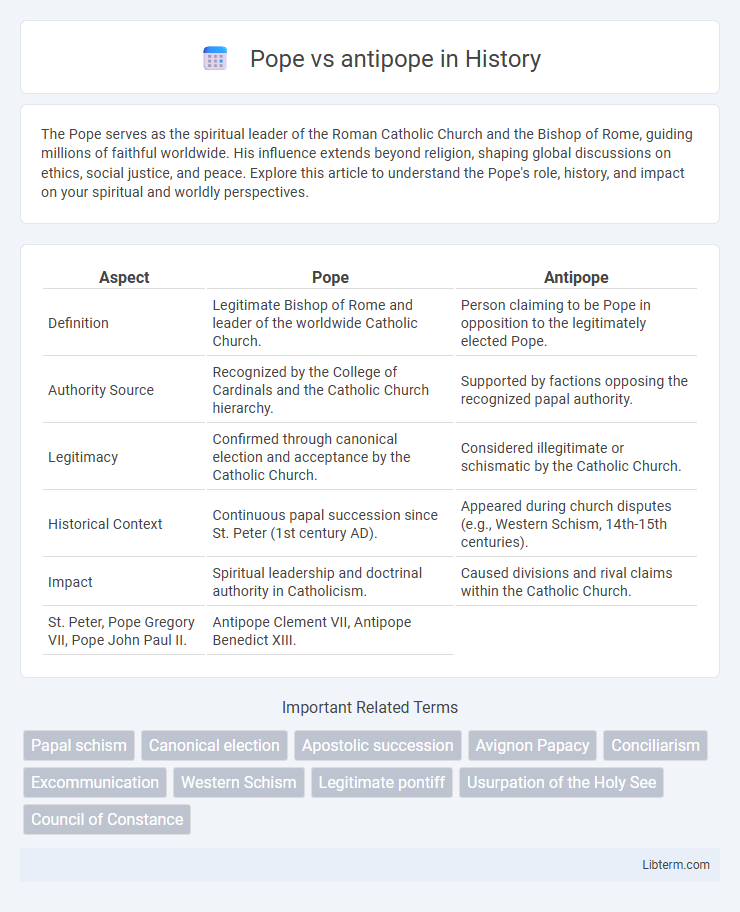The Pope serves as the spiritual leader of the Roman Catholic Church and the Bishop of Rome, guiding millions of faithful worldwide. His influence extends beyond religion, shaping global discussions on ethics, social justice, and peace. Explore this article to understand the Pope's role, history, and impact on your spiritual and worldly perspectives.
Table of Comparison
| Aspect | Pope | Antipope |
|---|---|---|
| Definition | Legitimate Bishop of Rome and leader of the worldwide Catholic Church. | Person claiming to be Pope in opposition to the legitimately elected Pope. |
| Authority Source | Recognized by the College of Cardinals and the Catholic Church hierarchy. | Supported by factions opposing the recognized papal authority. |
| Legitimacy | Confirmed through canonical election and acceptance by the Catholic Church. | Considered illegitimate or schismatic by the Catholic Church. |
| Historical Context | Continuous papal succession since St. Peter (1st century AD). | Appeared during church disputes (e.g., Western Schism, 14th-15th centuries). |
| Impact | Spiritual leadership and doctrinal authority in Catholicism. | Caused divisions and rival claims within the Catholic Church. |
| St. Peter, Pope Gregory VII, Pope John Paul II. | Antipope Clement VII, Antipope Benedict XIII. |
Defining the Terms: Pope and Antipope
The Pope is the recognized Bishop of Rome and spiritual leader of the Roman Catholic Church, holding supreme authority over doctrinal and administrative matters. An Antipope is a claimant to the papacy who opposes the pope recognized by the Catholic Church, often arising during periods of schism or political conflict. The distinction centers on legitimate ecclesiastical authority, with the pope acknowledged by the church hierarchy and the antipope representing a rival faction.
Historical Origins of the Papacy
The historical origins of the papacy trace back to Saint Peter, regarded as the first Bishop of Rome and the foundational figure establishing papal authority in the early Christian Church. Throughout history, conflicts between legitimate popes and antipopes emerged due to political, theological, and territorial disputes, challenging the unity and authority of the Roman Catholic Church. These rival claimants to the papal throne notably influenced the development of ecclesiastical doctrine and the complex power dynamics within medieval Europe.
Causes of Papal Schisms
Papal schisms primarily arise from disputes over legitimate papal succession, often triggered by rival factions within the College of Cardinals endorsing different candidates as pope, leading to the emergence of antipopes. Political interference by secular rulers and conflicting allegiances among European powers have historically intensified these divisions, notably during the Western Schism (1378-1417). Doctrinal disagreements, regional rivalries, and struggles for ecclesiastical authority exacerbate the legitimacy crisis between popes and antipopes, undermining Church unity.
Notable Antipopes in Catholic History
Notable antipopes such as Clement VII and Benedict XIII during the Western Schism challenged papal authority by establishing rival claimants to the papacy, creating significant divisions within the Catholic Church between 1378 and 1417. Antipopes like Felix V, elected by the Council of Basel in the 15th century, also contributed to periods of ecclesiastical disunity, complicating the recognition of legitimate pontiffs. These antipapal claimants often gained support from various factions and political powers, deeply influencing the Church's history and the development of papal legitimacy.
Key Papal-Antipope Conflicts
Key papal-antipope conflicts often centered on disputed legitimacy during turbulent periods like the Western Schism (1378-1417), where multiple claimants to the papacy divided Christendom. Notable conflicts include Pope Urban VI's contested election leading to Antipope Clement VII's rival papacy, and the Council of Constance (1414-1418) which ended the schism by deposing or accepting resignations of claimants and electing Pope Martin V. These clashes significantly impacted church unity, political alliances, and the evolution of papal authority within medieval Europe.
Criteria for Legitimate Papal Succession
Legitimate papal succession depends on canonical election by the College of Cardinals, adherence to apostolic tradition, and recognition by the broader Catholic Church. Popes are confirmed through valid conclaves, proper papal inauguration rites, and acceptance by the faithful and clergy. Antipopes arise from contested elections or schisms, lacking universal legitimacy and often condemned by Church councils.
Ecclesiastical and Political Impacts
The conflict between popes and antipopes significantly influenced ecclesiastical authority by challenging the legitimacy of papal succession and causing schisms within the Catholic Church. Politically, these disputes often aligned with regional powers, exacerbating tensions between monarchies and the papacy while affecting alliances across Europe. The resulting fragmentation weakened centralized church control, leading to prolonged disputes that shaped the development of both religious doctrine and secular governance.
Resolving Schisms: Church Councils and Reconciliation
Church councils such as the Council of Constance (1414-1418) played a pivotal role in resolving schisms by addressing disputes between popes and antipopes, ultimately restoring unity within the Catholic Church. These councils implemented formal processes of negotiation, deposition, and election to reconcile conflicting claims to the papacy. The resolution of the Western Schism exemplifies the church's reliance on conciliar authority to uphold legitimate papal succession and reestablish ecclesiastical stability.
Legacy of Antipopes in Modern Catholicism
The legacy of antipopes in modern Catholicism highlights the enduring challenges of papal legitimacy and ecclesiastical authority, as historical antipopes such as Clement VII and Benedict XIII influenced the resolution of the Western Schism and shaped contemporary Church unity. Their contested claims underscored the need for clearer mechanisms in papal elections, contributing to reforms like the conclave system established by Pope Gregory XV in 1621. Modern Catholicism regards antipopes as cautionary examples that emphasize the importance of canonical procedures and the spiritual unity of the Church.
The Papacy Today: Safeguards Against Schism
The Papacy today employs strict canonical procedures and rigorous vetting to maintain the legitimacy of the pope and prevent challenges by antipopes. The College of Cardinals, alongside the Vatican's Congregation for the Doctrine of the Faith, upholds doctrinal unity, reinforcing the papal office's authority. Modern communication and global ecclesiastical oversight act as vital safeguards against schism, ensuring fidelity to the recognized pontiff.
Pope Infographic

 libterm.com
libterm.com